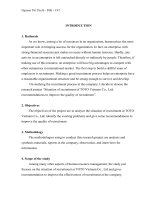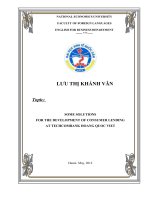Improve the quality of card services at techcombank – lang ha branch
Bạn đang xem bản rút gọn của tài liệu. Xem và tải ngay bản đầy đủ của tài liệu tại đây (515.12 KB, 91 trang )
ĐẠI HỌC QUỐC GIA HÀ NỘI
KHOA QUẢN TRỊ VÀ KINH DOANH
---------------------
NGUYỄN THỊ NGỌC ANH
IMPROVE THE QUALITY OF CARD SERVICES AT
TECHCOMBANK – LANG HA BRANCH
NÂNG CAO CHẤT LƯỢNG DỊCH VỤ THẺ TẠI NGÂN HÀNG
TMCP KỸ THƯƠNG - CHI NHÁNH LÁNG HẠ
LUẬN VĂN THẠC SĨ QUẢN TRỊ KINH DOANH
HÀ NỘI - 2020
ĐẠI HỌC QUỐC GIA HÀ NỘI
KHOA QUẢN TRỊ VÀ KINH DOANH
---------------------
NGUYỄN THỊ NGỌC ANH
IMPROVE THE QUALITY OF CARD SERVICES AT
TECHCOMBANK – LANG HA BRANCH
NÂNG CAO CHẤT LƯỢNG DỊCH VỤ THẺ TẠI NGÂN HÀNG
TMCP KỸ THƯƠNG - CHI NHÁNH LÁNG HẠ
Chuyên ngành: Quản trị kinh doanh
Mã số: 60 34 01 02
LUẬN VĂN THẠC SĨ QUẢN TRỊ KINH DOANH
NGƯỜI HƯỚNG DẪN KHOA HỌC: TS. HOÀNG ANH TUẤN
HÀ NỘI - 2020
ACKNOWLEDGMENTS
I assure, this is my own research. The data and research results in the thesis are
honest and no one has been published in any project.
Author of thesis
Nguyen Thi Ngoc Anh
i
THANK YOU
With deep, sincere affection, I would like to express my deep gratitude to all
individuals and collectives who have facilitated the process of studying and
researching this dissertation.
In particular, I would like to express my deep gratitude to Dr. Hoang Anh
Tuan, who guided and helped me a lot during the process of researching and
completing the thesis.
I would like to express my gratitude to all the teachers of HSB Vietnam
National University, Hanoi who taught and encouraged and facilitated me during
my time at the University as well as the time to complete this thesis.
I would like to thank the Board of Directors, colleagues at Vietnam
Technology and Commercial Joint Stock Bank - Lang Ha Branch for facilitating
and helping me complete this thesis.
Although the author has made many efforts, the thesis is difficult to avoid
certain limitations and shortcomings. Due to time limits and qualifications, the
thesis does not avoid shortcomings. We hope to receive the sincere advice and
contributions of teachers, teachers, friends, colleagues to improve the thesis. Once
again, thank you very much!
Hanoi, August 1st, 20120
Author of thesis
Nguyen Thi Ngoc Anh
ii
TABLE OF CONTENTS
ACKNOWLEDGMENTS............................................................................................ i
THANK YOU .............................................................................................................ii
TABLE OF CONTENTS .......................................................................................... iii
LIST OF DIAGRAM, FIGURE, TABLE, CHART ................................................. vi
PREAMBLE ............................................................................................................... 1
CHAPTER 1: QUALITY OF CARD SERVICES OF COMMERCIAL BANK ....... 5
1.1 Overview of card services of commercial banks ..................................................5
1.1.1 Concept of bank card service .............................................................................5
1.1.2 Bank card classification .....................................................................................5
1.1.3 The main activities of bank card services ..........................................................7
1.2 Quality of card services of commercial banks ....................................................11
1.2.1 Card service quality concept ............................................................................11
1.2.2 Criteria for evaluating card service quality. .....................................................12
1.3 Factors affecting card service quality .................................................................19
1.3.1 Economical factors ...........................................................................................19
1.3.2 Legal factor ......................................................................................................19
1.3.3 Technology infrastructure ................................................................................20
1.3.4 Recognize the role of ATM cards ....................................................................20
1.3.5 The habit of using non-cash payment methods ................................................21
1.3.6 The age of the participant .................................................................................21
1.3.7 Availability of ATM systems and bank card services .....................................21
1.3.8 Marketing policy of card issuer .......................................................................22
1.3.9 Utility of the card .............................................................................................22
1.3.10 Intention to use and decide to use ..................................................................22
CHAPTER 2: CURRENT SITUATION OF QUALITY OF CARD SERVICES AT
VIETNAM TECHNOLOGY AND COMMERCIAL JOINT STOCK BANK LANG BRANCH ...................................................................................................... 23
iii
2.1 Overview of Vietnam Technology and Commercial Joint Stock Bank - Lang Ha
Branch .......................................................................................................................23
2.1.1 History of formation and development of Vietnam Technology and
Commercial Joint Stock Bank - Lang Ha Branch .....................................................23
2.1.2 The introduction and development of card service Vietnam Technology and
Commercial Joint Stock Bank - Lang Ha Branch .....................................................23
2.2 Situation and quality of card services at Vietnam Technology and Commercial
Joint Stock Bank .......................................................................................................25
2.2.1 Status of card services of Vietnam Technology and Commercial Joint Stock
Bank - Lang Ha Branch.............................................................................................25
2.2.2 Quality of card services of Vietnam Technology and Commercial Joint Stock
Bank - Lang Ha Branch.............................................................................................36
2.3 Assessing the quality of card services at Vietnam Technology and Commercial
Joint Stock Bank - Lang Ha Branch ..........................................................................41
2.3.1 These achievements .........................................................................................44
2.3.2 Limited and causes ...........................................................................................45
CHAPTER 3: SOLUTIONS TO IMPROVE THE QUALITY OF CARD
SERVICES AT VIETNAM TECHNOLOGY AND COMMERCIAL JOINT
STOCK BANK - LANG HA BRANCH .................................................................. 51
3.1 Service development orientation of Vietnam Technology and Commercial Joint
Stock Bank - Lang Ha Branch ..................................................................................51
3.1.1 Overall service development orientation of Vietnam Technology and
Commercial Joint Stock Bank - Lang Ha Branch .....................................................51
3.1.2 Orientation of card service development of Vietnam Technology and
Commercial Joint Stock Bank - Lang Ha Branch .....................................................54
3.2. Solutions to improve the quality of card services at Vietnam Technology and
Commercial Joint Stock Bank - Lang Ha Branch .....................................................58
iv
3.2.1. Improve and develop card products ................................................................58
3.2.2. Expand the network of units accepting card payments. ..................................63
3.2.3. Improve the quality of research and market definition ...................................66
3.2.4. Technical innovation and modernization of technology .................................69
3.2.5. Training and developing human resources. ....................................................72
3.2.6. Prevention and handling of risks in the card sector ........................................73
3.3 Some recommendations ......................................................................................74
3.3.1 Propose to the Government ..............................................................................74
3.3.2 Propose to the State Bank of Vietnam .............................................................76
3.3.3 Propose to the Association of Card Issuing and Payment Banks in Vietnam .78
CONCLUDE ............................................................................................................. 80
LIST OF REFERENCES .......................................................................................... 82
v
LIST OF DIAGRAM, FIGURE, TABLE, CHART
Diagram 1.1: CARDS BUSINESS PROCESS [8] .......................................................7
Figure 1.1: Service quality model .............................................................................14
Figure 2.1: NUMBER OF DOMESTIC CREDIT CARD ISSUED TO 2019 .........32
Table 2.1 DOMESTIC DEBIT CARD FEE .............................................................27
Table 2.2 DOMESTIC CREDIT CARD TABLE .....................................................30
Table 2.3 SUCCESS CARDS CHARGES USED THROUGH BANKNETVN
SYSTEM ...................................................................................................................33
Table 2.4. Results of customer comments ................................................................41
Table 2.5. Percentage of customers having trouble with Techcombank's Lang Ha
ATMs in 2019 ...........................................................................................................46
Table 2.6. The table compares the service fee schedule to pay for goods and
services at some banks in the area.............................................................................47
Table 3.1. CARD DEVELOPMENT PLAN FOR 2019 - 2024 ...............................56
Table 3.2 DEVELOPMENT PLANNING FOR ACCEPTING CARD (2019 - 2024) ..57
Chart 2.1 NUMBER OF DEBIT CARD ISSUED DOMESTIC TO 2019 ...............28
vi
PREAMBLE
1. The urgency of the topic
The economy of our country in recent years has seen strong growth, marking
development steps in both depth and breadth. Especially after our country joined the
World Trade Organization (WTO), Vietnam became a destination for domestic and
foreign investors. All of these initial successes cannot help but mention the great
contribution of the banking system across the country. Along with the development
and integration of the economy, the banking industry is also making great changes,
step by step innovating and meeting the increasing demands of domestic customers.
In order to survive and develop sustainably, domestic commercial banks not
only have to innovate on technology, improve management methods, modernize the
payment system, but also pay more and more attention. More importantly, further
improve the quality of its services. Prior to the 2000s, banking services were mostly
encapsulated in savings deposit taking, money transfer and lending services to
customers, recently in the field of banking retail services, bank cards. The bank has
emerged as a multifunctional personal finance product, bringing many utilities to
customers. The card can be used to withdraw money, deposit money, provide credit,
make payment for goods or services, or transfer money. The card can also be used for
many non-financial services such as account information lookup, cost of living
information ...
The card service has many advantages in satisfying customers' needs because
of its convenience, safety and widely used in the world, especially in developed
countries. The development of card services is becoming an indispensable trend by
those banks, and continues to attract attractive benefits from this feature-rich card.
With the efforts of commercial banks, the card service with its utilities is no
longer a strange product but has gradually entered the lives of many people.
According to the State Bank's report, in 2019, the speed of payment card issuance
increased by 30% compared to 2017, reaching a total of 3.5 million cards issued
with nearly 60 different brands. When issuing a card, the bank will collect fees
related to issuance such as card usage fee, interest rate (with credit card) and
1
especially using idle deposit balance in card accounts of cutomer. However, bank
card service is a service developed on the basis of modern technology, reaching
international standards of banks. The competition in the development of card
services has led banks to focus on increasing features and utilities, superior service
technology, diversifying card products and services, and making efforts to bring
them to customers quality products and differentiated added values to attract more
cardholders at home and abroad. The competition to develop card services of
commercial banks is becoming more and more exciting than ever.
However, the infrastructure for card services of commercial banks is
generally outdated, technical equipment for transactions is still limited. The quantity
and quality of ATMs did not meet the customer's ATM transaction needs. ATM
systems are distributed evenly, most ATMs are concentrated in big cities or
branches of banks. In addition, many common risks may be the slow transmission
speed, consumer errors during use ... The risks, incidents and limitations related to
ATM and ATM cards greatly affect many opportunities to develop card services
and promote cashless payments. Therefore, the task of preventing risks and
overcoming these limitations to improve the quality of card services and increase
customers is a very important task for commercial banks.
The card service has actively contributed to improving the civilization of
payment, increasing the competitiveness of banks in the integration process. The
fact has proved the role of bank card services as a strategic spearhead in
modernizing and diversifying types of banking services, bringing many utilities to
customers. However, viewed objectively, the market of bank cards in Vietnam is
still in the early stages, the products and services provided are not diversified,
besides many favorable opportunities. As many challenges require commercial
banks in general and Vietnam Technology and Commercial Joint Stock Bank Lang Ha Branch in particular to have reasonable business solutions. In addition,
Hanoi is a large potential area for card service to develop, but the fierce competition
of commercial banks in the area and the habit of keeping cash of the majority of
people. Hanoi requires the leadership and staff of Vietnam Technology and
2
Commercial Joint Stock Bank - Lang Ha Branch to find strategies to develop card
services in a reasonable way that best suits their operating areas.
Originating from the above practice, as a cardist at Vietnam Technology and
Commercial Joint Stock Bank, the author chooses the topic: "Improving the quality
of card services at Vietnam Technology and Commercial Joint Stock Bank - Lang
Ha Branch" to research to solve these problems.
2. Research objectives:
Researching basic theoretical issues about the quality of commercial bank
card services
Analyze and assess the status of card service quality at Vietnam Technology
and Commercial Joint Stock Bank - Lang Ha Branch.
Propose solutions and recommendations to improve card service quality at Vietnam
Technology and Commercial Joint Stock Bank - Lang Ha Branch.
3. Object and scope of the study:
- Research subjects: Quality of card services of commercial banks.
- Scope of research: Card service quality at Vietnam Technology and
Commercial Joint Stock Bank - Lang Ha Branch from 2018 to 2019.
4. Research Methods
Use qualitative and quantitative methods. Collecting documents, observing
customer behavior, then analyzing data about the environment, customers, and
direct competitors.
5. Overview of research documents
In order to gain the basic knowledge and foundations that form the
theoretical basis for the topic, the author has consulted, summarized, summarized
and inherited from some documents of the following authors:
+ Marketing Theory: Document "Basic Marketing" by Assoc. Prof. Dr.
Nguyen Thi Nhu Liem, "Marketing Management" by Assoc. Prof. Dr. Le The Gioi Dr. Nguyen Xuan Lan.
3
+ Theory of Banking: Document "Modern banking operations", "Credit and
credit appraisal of banks", by author Dr. Nguyen Minh Kieu and the document
"Bank credit", by the author Dr. Ho Dieu.
In the process of implementing the topic, the author also consulted from a
number of relevant studies, thereby helping the author have an overview of the field
being studied, and help the author draw the research orientations and methods as
well as suggestions and solutions to suit their topics.
6. Thesis structure:
The thesis consists of 3 chapters:
Chapter 1: Quality of card services of Commercial Bank
Chapter 2: Actual situation of card service quality at Vietnam Technology and
Commercial Joint Stock Bank - Lang Ha Branch.
Chapter 3: Solutions to Improve card service quality at Vietnam Technology and
Commercial Joint Stock Bank - Lang Ha Branch.
4
CHAPTER 1
QUALITY OF CARD SERVICES OF COMMERCIAL BANK
1.1 Overview of card services of commercial banks
1.1.1 Concept of bank card service
Bank card service is a payment instrument issued by a card issuing bank to its
customers for payment of goods, services or cash withdrawal within the scope of
their deposit balance or granted credit limit. Bank cards are also used to perform
services through automated teller systems, or ATM self-service systems. According
to the "Regulation on issuance, use and payment of bank cards" issued together with
Decision No. 371/1999 / QD / NHNN in October 19th, 1999, bank cards are
payment instruments issued by banks for use by customers under contracts signed
between banks and cardholders.
Bank cards are always made of plastic according to international standard
sizes, including the following elements:
- The trade mark of the card, name and logo of the bank or card issuer
- The validity period or the time of card usage
- Card rank (standard / gold / special)
- Card number, cardholder name, security factors
- In addition, the card may also have the name of the company responsible for
payment or some other factors as prescribed.
1.1.2 Bank card classification
According to the payment nature of cards, bank cards are classified into:
* Credit Card: this is the type of card that when used, the cardholder is issued a
credit limit issued by the issuing bank and does not have to pay an error if the
cardholder refunds the correct amount of money used tenor to purchase goods and
services at business establishments, shops, hotels ... accept this card.
* Debit Card: is a means of payment for goods, services or cash on the basis of the
amount of money in the cardholder's account at the bank. Debit cards have two
basic types:
5
- On-line card is a debit card that the value of the transactions is immediately
deducted from the cardholder's account when the transaction appears.
- Off-line is a debit card that the value of the transactions will be deducted from the
cardholder's account after a few days of transactions.
Debit and credit cards have a number of distinct differences:
The biggest difference between the two types of cards is that with credit
cards, customers spend according to the credit limit granted by the bank, while with
debit cards customers spend directly on their deposit accounts at banks.
Credit and debit cards are a means of equal payment and open to all people, all
ages and industries. Both types of cards can help customers avoid the unfortunate risks
that may occur when carrying cash. In particular, international credit cards are a
convenient and safe means of payment for those who often travel abroad.
* Cash Card: is a form of debit card but has only one function is to withdraw cash
at automatic teller machines (ATMs) or banks. With a special function for
withdrawing money only, the amount withdrawn each time will be deducted from
the deposit amount.
6
1.1.3 The main activities of bank card services
(2) Buy goods and services
Department for
card accept
CARD OWNERS
International card
organization
Card issuing bank
Card payment
bank
(6) Credit
advice
(8) Debit
notices
Diagram 1.1: CARDS BUSINESS PROCESS [8]
Customers - cardholders buy goods and services at the card accepting units
provided by the issuing bank.
The merchant accepts the card of the transaction at the card payment bank.
The card payment bank advances the card payment amount (equal to the total value
of the presented invoice minus the agency fee as agreed) by crediting the account of
the accepting unit.
Card payment bank sends card transaction data to the issuing bank for
payment through the card exchange and payment system of international card
organizations. Based on the received transaction data, the international card
organization shall credit the payment bank account (equal to the total value of the
transaction invoice minus the exchange fee prescribed) and debit the issuing bank
account. card.
Card issuing bank requires customer-card holder.
7
(4) Advances
(3) Payment invoice
(1) Card issuance
(9) Submit statement
(10) Payment
(5) Submit data
(7) Submit data
The cardholder pays the issuing bank for the payment for goods and services
provided by the card accepting units.
The above process shows that card payment is a process of buying and selling
bearing goods and services in which the participants must pay each other: the card
accepting unit for the cardholder, the payment bank for the card accepting unit, the
issuing bank and the bank pay the loan and claim the loan from the cardholder. The
whole process is regulated, regulated and managed by a unified organization in the
world, the international card organization.
Thus, in order to carry out card service business, banks normally have to carry
out professional activities including: issuing activities, payment activities and risk
management activities.
1.1.3.1 Card issuing activities
Card issuance activities of the bank include the implementation and
management of the whole process of card issuance to the market, card use and debt
collection by cardholders. Basically card issuance service includes the following
main contents:
- Elaborating regulations on card issuance, use and debt recovery such as:
issuance dossier, withdrawal limit, payment, bank transfer, minimum payment
amount, statement date, grace period term, fees and charges, maximum credit limit,
minimum, preferential policies for cardholders, ...
- Appraise customers issuing cards, granting payment limits
- Design and organize the purchase of blank cards, print and encode cards,
create PIN numbers for customers
- Manage customer information and card usage activities of customers:
Resolve all requests related to customers 'use of cards, make an update to the
system of all transactions using customers' cards line,…
- Manage customer debt collection situation
- Providing customer service
- Organize payment with payment banks and international card organizations,
card centers.
8
For card issuance activities, in addition to enjoying the issuance fee collected
from the cardholder, the issuing bank is also entitled to a fee shared by the payment
bank from the card payment fee, benefiting from the current deposit source. .. This
is the basic profit of financial institutions, card issuers. On the basis of this revenue,
the financial institutions and card issuers offer other interest-free and preferential
regimes for customers to attract customers as well as encourage card spending.
1.1.3.2 Card payment activities
Along with card issuance activities, card payment activities play a decisive
role in the development of card services. Card payment activities of a bank include
the following main contents:
- Develop and manage the information system that accepts cards
- Manage the operations of the card acceptance network
- Organize payment of card usage transactions to card accepting units
- Providing customer service
- Organizing training courses on card payment knowledge for employees of
card accepting units
- Provide equipment and supplies for card payment
The implementation of card payment activities helps the bank to profit from
the fee calculated on the value of card payment transactions from the card accepting
units, and thereby providing customers with a convenient service, create a convenient
basis for the use of the card. One of the important activities of the bank in card service is
to expand the network of card accepting units, which is very important.
First of all, the large number of merchants that accept cards across the markets
and businesses means that bank cards are accepted for payment in more places, are
easier, more convenient and bring More benefits for cardholders, the card accepting
units and then the issuing banks and card payment banks.
Not only expanding the payment market by signing payment contracts with
new card accepting units, a card payment bank is particularly interested in
maintaining relationships with the available card accepting units. Yes, shown in
customer care. Without appropriate policies, good support services, enabling card
9
accepting units to accept card payments easily, the bank informs them of its
commitment after that, At discount rates, other banks will take advantage of this
opportunity to offer better services to merchants. Thus, customers in payment
activities will be reduced, the profit-earning goals of banks will be deeply affected.
Currently, card payment activities in the international market have grown at a
very high level with over hundreds of thousands of card accepting units in over 200
countries, accepting cards bearing world-famous brands such as Visa Card. , Master
Card, American Express, Diners Club, JCB and many other national and domestic bank
cards. In Vietnam, although the bank card is still new, it has met the payment needs of a
large number of foreign customers as well as the growing domestic market.
In addition, in the process of card issuance and payment, there are also
transactions: tracing, claiming and claiming reimbursement, managing risks in card
service activities ... in order to prevent fraud and counterfeiting acts. card, solving
problems for cardholders, thereby contributing to improving the quality of card
services, strengthening the bank's reputation.
1.1.3.3 Risk management activities
Any business in any industry involves a lot of risk. So is the card service
business of commercial banks. Risks and risks may occur at any time during the
process of card issuance, use and payment, causing damage to cardholders,
establishments accepting and analyzing, learning and work together to be able to
cope with risks and prevent risks by using appropriate technical and business
measures effectively. A business card bank is very vulnerable, even bankruptcy
if not pay attention to this problem.
Risk management activities in card services include the following:
- Investigate, prevent the use of fake cards. Manage the list of accounts
related to the cards that have been reported as stolen or lost. Develop plans to
track the security of blank, printed and damaged cards, and recalled cards.
- Update information on the list of stolen and lost cards. Addressing the
needs of counterfeiting, tracing and complaints of customers.
- Cooperate with relevant authorities in investigating and handling
10
contractual and counterfeiting violations.
- Organize training for staff of card accepting units and cardholders on
counterfeiting prevention measures.
1.2 Quality of card services of commercial banks
1.2.1 Card service quality concept
Scientists have done a lot of research on service quality, depending on
different perspectives, the researchers, business practitioners, businesses can offer
or use different perceptions of service quality. Some views about quality come from
producers, consumers, from products or market requirements:
First opinion [3]: Compared to a tangible product, the "service quality" is much
harder to identify, measure, control and improve because the product of the service is
intangible, not stored, non-reproducible, depending on the individual, spontaneous,
irreversible and encompassing the emotional element. This view is that "service quality"
is defined and defined. price by the customer, not the service provider.
The second point of view [3]: "Service quality" is customer satisfaction defined
by a comparison between expected quality and achieved quality. Quality
expectation is the expectation of customers about service quality. Customer
expectations are generated by the following 4 sources of information; Word of
mouth, personal needs, experience, advertising and promotion. Of the 4 sources of
information on the 4th source is under the control of the company
The above views have not yet reflected the nature of quality. The most
general way "Service quality" is the level of customer satisfaction in the process of
perceiving service consumption, which is the overall service of the business that
brings the most benefit chain and satisfies the most expected demand of customers
in production, supply and output service delivery ”. This view represents the quality
defined by the customer and not by the service provider. Customers evaluate the
quality of services provided through the provision of services by the business and
assess the people who stand by. Quality of products and services is an issue at all
levels of production, it is an objective requirement in the process of creating
products, so it is not reserved for any level. The output and quality levels are
11
different.
The quality of card services also adheres to the characteristics of general
service quality. Thus, card service quality can be understood as follows: Card
service quality is the satisfaction and satisfaction of customers in the process of
perceiving the use of card services that enterprises bring.
1.2.2 Criteria for evaluating card service quality.
Service industry is growing, the service quality is focused and invested in
research. Although there is still no consensus among researchers about service
quality, most of the views recognize that service quality is closely related to
customer satisfaction (Cronin and Taylor, 1992; Spereng , 1996; cited by Bexley,
2005)
[15]
and service quality will be a measure of customer service expectations
(Lewis Booms, 1982). According to Parasuraman & ctg (1985, 1988) "Service
quality is the distance between customer expectations and their perception when
used through the service".
[1]
For a long time, many researchers tried to define and measure service
quality. For example, Lehtinew & Lehtinew (1982) suggest that service quality
must be assessed on two aspects (1) the service delivery process and (2) the
outcome of the service. Gronroos (1984) also proposed two areas of service quality:
(1) technical quality and (2) functional quality. Parasuraman et al (1985) provide a
model of five gaps and five service quality components, referred to as SERVQUAL.
The SERVQUAL scale is made up of two words Service - service and Quality quality that many researchers consider to be quite comprehensive (Svensson, 2002).
* Service quality model SERVQUAL
Model of five service quality gap: [4]
A widely used measure of service quality is the SERVQUAL model
developed by Parasuraman & ctg (1985,1988). The SERVQUAL model is the most
used approach to measure service quality, compare customer expectations before a
service and customer perception of the service delivered. Parasuraman & ctg
(1985,1988) proposed a model of five service quality gaps.
The first gap: Appears when there is a difference between customer
12
expectations about service quality and service administrators feel about customer
expectations about service quality. The basis of this difference is that the service
company does not fully understand what makes the quality of its services and how
to deliver them to its customers to satisfy their needs.
The second gap: Appears when a service company has difficulty translating
its perceptions of customer expectations into characteristics of quality. In many
cases, the company can always translate these expectations into specific quality
criteria and deliver them to customers with the characteristics of service quality.
The main reason is the professional competence of the service staff as well as
fluctuations in service demand. There are times when the demand for services is so
high that the company cannot meet it.
Third gap: Appears when service personnel do not transfer services to
customers according to defined criteria. In service, employees have direct contact
with customers, playing an important role in the process of creating quality.
However, not always and all employees can complete the task according to the set
criteria.
13
Information from
various sources
Previous
experience
Personal needs
Expected service
Different 5
Reception service
CUSTOMERS
Information to
customers
Transfer service
Convert comments
into quality
requirements
SUPPLIERS
Different 3
Different 4
Different 1
Awareness of the
company about
customer expectations
Different 2
Figure 1.1: Service quality model
Source: Nguyen Dinh Tho 2003, Adapted from Parasuraman & ctg. (1985:44)
Fourth gap: Advertising media and information also impact on customer
expectations of service quality. Promises in promotional programs can increase
customer expectations but also reduce the quality that customers feel when they are
not being fulfilled.
Fifth gap: This gap appears when there is a difference between quality and
expectation by customers and the quality they perceive. Quality of service depends
on this fifth gap. When customers realize that there is no difference between the
quality they expect and the quality they perceive when they consume a service, the
quality of the service is considered perfect. Parasuraman & ctg (1985,1988) think
that service quality is a function of the fifth distance, which depends on the previous
14
distance. That is, gaps 1,2,3 and 4. Therefore, in order to shorten the fifth gap and
increase the quality of service, service administrators must try to shorten these gaps.
The service quality model, according to these researchers, can be expressed as
follows:
CLDV = F { KC5 = f(KC1,KC2,KC3,KC4)}
Inside:
CLDV : Service quality
KC1,KC2,KC3,KC4,KC5: the gap 1,2,3,4 and 5.
According to Parasuraman & ctg (1985), the service quality perceived by
customers is a 10-component model that is:
1. Reliability refers to the ability to deliver services appropriately and on time
from the beginning.
2. Responsiveness expresses the desire and willingness of service staff to
provide services to customers.
3. Competence refers to the level of expertise required to perform a service,
the ability to service it when the employee comes in contact with the customer, the
employee directly performing the service, the ability to research to capture relevant
information needed for customer service.
4. Access involves creating all conditions for customers easy access to
services such as shortening waiting time of customers, places of opening hours
convenient for customers.
5. Courtesy speaks out about a friendly, respectful and customer-friendly
service personality.
6. Information relating to communication and communication with customers
in a language they understand easily and listen to issues related to them such as
service explanation, costs, complaint settlement Complaints questions.
7. Credibility speaks up the ability to create trust for customers, making
customers trust in the company. This ability is reflected in the name of the
company, the personality of the service staff to communicate directly with
customers.
15
8. Security refers to the ability to ensure the safety of customers.
9. Understanding / Knowing the Customer is demonstrated by the ability to
understand the needs of customers by understanding the requirements of customers
who care about them personally and identify regular customers. .
10. Tangibles are shown through appearance, attire of service staff, and
equipment for service.
The above 10 service quality model has the advantage of covering almost every
aspect. However, this model has the disadvantage of being complicated in
measurement. Moreover, this model is theoretical, and it is possible that many
components of the service quality model will not achieve discriminatory value.
Therefore, these researchers have repeatedly tested this model and came to the
conclusion that service quality consists of 5 basic components which are:
1. Reliability is demonstrated by the ability to perform services appropriately
and on time from the beginning.
2. Responsiveness expressed through the desire and availability of service staff
to provide timely services to customers.
3. Assurance shows the level of expertise and service standards courteous and
affable with customers.
4. Empathy demonstrates the care and concern for each individual customer.
5. Tangibles are shown through appearance, attire of staff, equipment and
facilities for the service.
Therefore, to assess the quality of card services, we also use the following
criteria:
a) Some qualitative indicators
- Reliability: Reliability is shown the ability to perform the service as promised
exactly and timely, accompanied by a flawless service style. Failure to keep the
promise is the most frustrating source for customers, if this happens repeatedly it will
quickly lose customers.
- Responsibility: Responsibility is the ability to reflect the willingness to serve
customers best, safest. Besides, it requires a level of recovery when risks occur in the
16
fastest and safest way. At the same time, employees need to know their products and
services, need to be able to easily communicate the information they need to customers,
and need to be willing to go a few miles to answer customers' questions.
- Assurance: The assurance shown is the courtesy, respect and customer trust of
the service staff, so this guarantee must be given adequate attention, that is, always
care, do good to customers. A polite and caring attitude is very important and
necessary. Customers will feel you appreciate their work.
- Empathy: Empathy with customers demonstrates the ability to understand
customers, share with customers joy and sadness and reassure customers.
- Tangibles: Tangibles is reflected in material facilities, applied equipment,
appearance, manner of decoration, location. These factors give customers a sense of the
quality of the service or through which people see the level of service.
b) Some quantitative indicators
- Revenue: Sales revenue is the total amount of sales of products, goods,
services provided to customers including surcharges and additional charges outside
the selling price (if any). The sales amount is stated on the invoice (VAT), the sales
invoice, or on other documents relating to the sale, or the price agreed upon
between the buyer and seller. Improving product quality and service quality not
only affects selling price but also consumption volume. High quality products, the
price will be high. Improving product quality and service delivery quality will add
product value and service value, facilitate easy sales, quickly collect sales money
and increase sales.
- Profit: Profits are the difference between revenues earned and expenses
spent. The profitability of the business depends on the quality of its operations and
its management. Profits are general indicators representing the results of production
and business processes. It fully reflects the quantity and quality of operations of the
enterprise, reflects the results of the use of basic production factors such as labor,
materials, fixed assets, etc.
- Market share: The market share of an enterprise for a type of goods or
service is a percentage of its turnover (buying or selling) and the total revenue of
17









